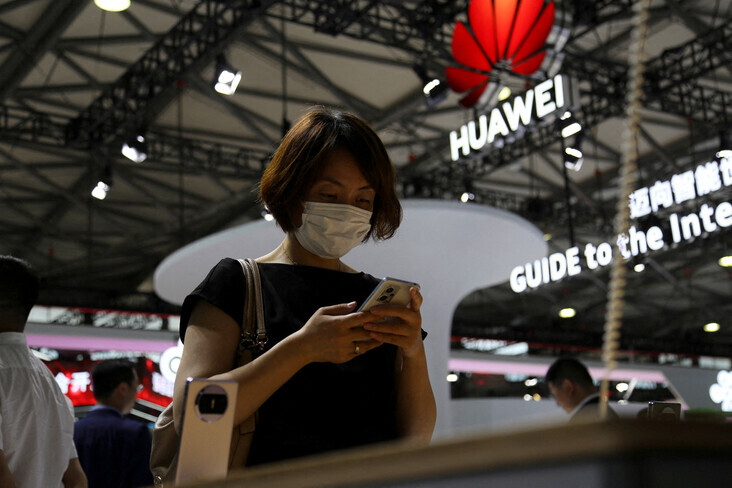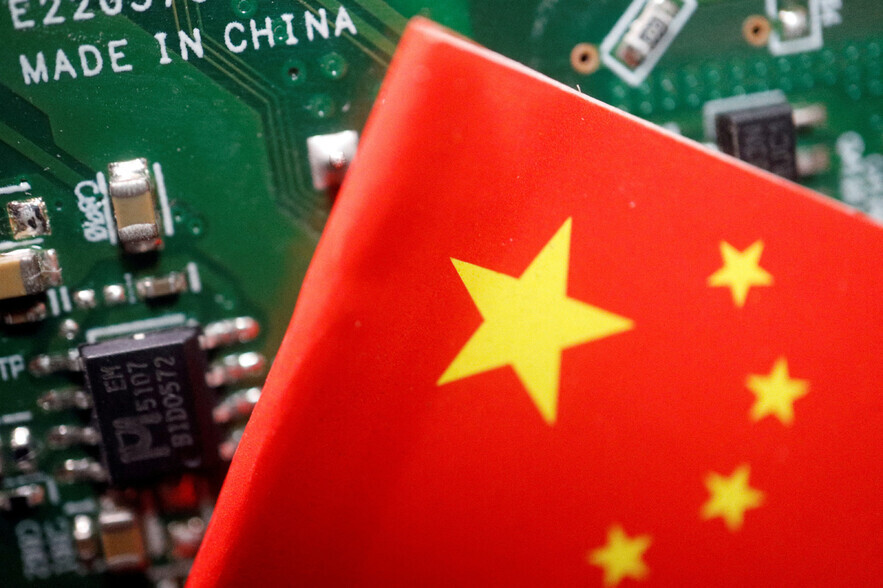hankyoreh
Links to other country sites 다른 나라 사이트 링크
Huawei’s newest smartphone could trigger tighter US tech sanctions on China

The high-performance smartphone that Chinese tech firm Huawei unexpectedly unveiled last month continues to produce shock waves. Experts think the US will tighten its technical sanctions on China and that the technological race between the two countries will heat up.
Reuters cited analysts from Jefferies, a global investment bank, as saying that Huawei’s new phone “could trigger a probe from the US Commerce Department's Bureau of Industry and Security [. . .] and prompt Congress to include even harsher tech sanctions in a competition bill it is preparing against China.”
“Overall the US-China tech war is likely to escalate,” the analysts were quoted as saying.
The US has been blocking certain American exports to China since the Trump administration on the grounds that Huawei products pose a threat to US national security.
In May 2019, Huawei was added to the US Commerce Department’s entity list that places restrictions on trade, blocking exports from US companies. Then in August 2020, the US further restricted foreign products that are made with American technology.
A crucial example is the extreme ultraviolet (EUV) lithography equipment exclusively manufactured by Dutch company ASML — equipment that’s essential for the production of the latest semiconductors. The prevailing view was that these sanctions would keep Huawei from producing 5G smartphones.
Last October, the Biden administration went one step further by effectively banning the sale of cutting-edge semiconductors and semiconductor manufacturing equipment to all of China. Then this past August, it restricted US-based capital from being invested in Chinese companies that are involved in advanced semiconductors, AI and quantum technology.
The performance of Huawei’s new Mate 60 Pro and the details of the chip that powers it are now raising questions about the effectiveness of US technology sanctions on China.
The smartphone is reported to have similar performance and speeds to 5G smartphones released by Samsung, Apple and other companies. In other words, China’s semiconductor production capacity has proven to be much better than expected.
TechInsights, an information platform based in Canada, reported that a teardown of the Mate 60 Pro revealed that the semiconductor used in the smartphone appears to use 7-nanometer technology. One nanometer (nm) is equal to one billionth of a meter.
Chinese media outlets such as Caixin reported that the semiconductor used is Huawei’s in-house developed “Kirin 9000S” and is made by China’s largest semiconductor foundry, Semiconductor International Manufacturing Corp. If this is correct, US sanctions meant to inhibit China’s semiconductor development have flopped.

Samsung Electronics began mass production of the 7 nm process in 2018. China still faces a five- to six-year technology gap with Taiwan and South Korea, which boast the world’s top semiconductor manufacturing capabilities.
However, the domestic and international semiconductor industry have, until now, estimated that China is only at the 14 nm technology level.
China Central Television (CCTV) quoted a Chinese expert admitting that there is still a “big gap” from the most advanced technology, but that while the West sees a three- to five-year gap from 5G semiconductors with advanced manufacturing processes, this is judged according to their pace of technological progress, which China often surpasses.
Dan Hutcheson, the vice chair of TechInsights, wrote that the discovery “demonstrates the technical progress China’s semiconductor industry has been able to make” and that the semiconductor yield of 7-nm technology appears to have been resolved.
That being said, it remains to be seen whether China can mass-produce 7 nm chips at an affordable price.
The Mate 60 Pro was available in limited quantities, selling out within hours of its launch.
Huawei appears to have a limited inventory of the semiconductors used in its new smartphone, said Jefferies, the investment bank, adding that the company may have used semiconductors from TSMC that it had stockpiled before the US imposed its sanctions.
Chinese state media continue to report that China has broken through US-imposed technological blockades.
“We advise some Americans to deconstruct and reconstruct their concept of China's technical development and innovation, in addition to disassembling smartphones,” the state-run Global Times wrote in an editorial titled “Some Americans should look beyond disassembling phones.” The piece argued that “in recent years, not only Huawei but also many other Chinese enterprises have made substantial headway in areas where the US pushed to ban China, such as aerospace, photovoltaics and energy.”
There are also reports that the Chinese government will create an additional 300-billion-yuan (US$41 billion) fund to revitalize the semiconductor industry.
Reuters, citing inside sources, reported that the new fund will focus on investments in equipment for chip manufacturing.
China’s finance ministry will reportedly contribute 60 billion yuan (US$8.2 billion), or 20 percent of the total fund.
By Choi Hyun-june, Beijing correspondent
Please direct questions or comments to [english@hani.co.kr]

Editorial・opinion
![[Guest essay] Preventing Korean Peninsula from becoming front line of new cold war [Guest essay] Preventing Korean Peninsula from becoming front line of new cold war](https://flexible.img.hani.co.kr/flexible/normal/500/300/imgdb/original/2024/0507/7217150679227807.jpg) [Guest essay] Preventing Korean Peninsula from becoming front line of new cold war
[Guest essay] Preventing Korean Peninsula from becoming front line of new cold war![[Column] The state is back — but is it in business? [Column] The state is back — but is it in business?](https://flexible.img.hani.co.kr/flexible/normal/500/300/imgdb/original/2024/0506/8217149564092725.jpg) [Column] The state is back — but is it in business?
[Column] The state is back — but is it in business?- [Column] Life on our Trisolaris
- [Editorial] Penalties for airing allegations against Korea’s first lady endanger free press
- [Editorial] Yoon must halt procurement of SM-3 interceptor missiles
- [Guest essay] Maybe Korea’s rapid population decline is an opportunity, not a crisis
- [Column] Can Yoon steer diplomacy with Russia, China back on track?
- [Column] Season 2 of special prosecutor probe may be coming to Korea soon
- [Column] Park Geun-hye déjà vu in Yoon Suk-yeol
- [Editorial] New weight of N. Korea’s nuclear threats makes dialogue all the more urgent
Most viewed articles
- 1Behind-the-times gender change regulations leave trans Koreans in the lurch
- 2South Korean ambassador attends Putin’s inauguration as US and others boycott
- 3Yoon’s revival of civil affairs senior secretary criticized as shield against judicial scrutiny
- 4Family that exposed military cover-up of loved one’s death reflect on Marine’s death
- 5AI is catching up with humans at a ‘shocking’ rate
- 6Yoon’s broken-compass diplomacy is steering Korea into serving US, Japanese interests
- 7[Guest essay] Preventing Korean Peninsula from becoming front line of new cold war
- 8Japan says its directives were aimed at increasing Line’s security, not pushing Naver buyout
- 91 in 10 marriages in Korea last year was with a foreign national
- 10[Column] The nuclear umbrella and the afterlife